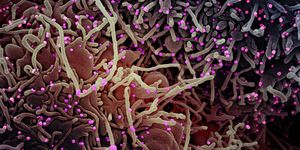Small RNA is Connected to Bacterial Pathogenicity
It's thought that over half of the global population carries a bacterium called Helicobacter pylori in their stomach. While it's often harmless, in some people the microbe can cause inflammation and may lead to ulcers or the development of stomach cancer. The bacterium has ways to hide out in the niches of the stomach and has virulence factors that can enable it to withstand the harsh environment there and cause disease. Researchers have now learned that a small bacterial RNA molecule called NikS is regulating many of these factors. The findings have been reported in Molecular Cell.
The scientists found that NikS is helping to control four genes: two of H. pylori's critical virulence factors and two encoding for outer membrane proteins. NikS is helping control the gene encoding for the bacterial oncoprotein CagA, which has a major role in H. pylori-induced cancer development
"With the knowledge of the different functions and underlying molecular mechanisms of this small RNA during infection and the associated bacterial signaling pathways, we can gain new targets for the development of novel antimicrobial strategies," said the senior study author Professor Cynthia Sharma, the Chair for Molecular Infection Biology II at Julius-Maximilians-Universität (JMU) Würzburg.
H. pylori can survive in the inhospitable stomach environment in part because of a mechanism called phase variation, in which random gene mutations are employed by bacteria. This gives a microbial population flexibility so it can adapt and survive, at least some of the bacteria in a population will be ready to generate the right amount of protein at the right time.
This work has suggested that phase variation does not only impact genes that encode for proteins; it also influences small, non-coding RNA molecules like NikS. Different levels of NikS might be affected by phase variation, which would impact disease-causing factors. NikS was also shown to affect how bacteria enter host cells.
"This mechanism could play a major role in enabling Helicobacter pylori to adapt successfully to the variable stomach environment and thus chronically colonize its host," said Sharma.
The researchers want to know more about how NikS is involved in the ability of H. pylori to colonize different parts of the stomach, and the effect it has on bacterial genes and pathogenicity.
Soures: AAAS/Eurekalert! via University of Würzburg, Molecular Cell









